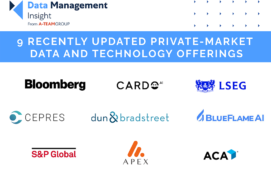The question of what the merger of Bank of New York and Mellon would mean for the two data management vendors owned by the banks, Netik and Eagle Investment Systems respectively, has been answered, as Netik reveals its new primary investor as Symphony Technology Group. The two-part deal orchestrated by Netik (with Marlin & Associates as advisor) also answers another question: whether Capco, as a consultancy firm, would stick in the managed reference data services business. The answer is no, as Netik has also acquired Capco Reference Data Services (CRDS) with a view to fulfilling its vision of transforming from a pure software provider to a player in the software and service business.
Netik insiders always maintained that the Bank of New York’s interest in Netik was more as an investment and that by contrast to the Mellon/Eagle relationship, its technology was less entrenched within its bank owner’s business. Subsequent events seem to bear out the accuracy of this positioning, though a spokesperson for BNY Mellon Asset Servicing says the sale of the bank’s primary stake in Netik “was a simple by-product” of the merger.
“It was a business decision, not a technology decision, made in conjunction with the Netik management,” the spokesperson continues. “Post-merger, we were the owner of two leading companies in their space, and so found ourselves with overlapping product offerings. As part of our merger analysis, we determined that it would not be effective to combine the two.”
While we must assume that BNY Mellon is content for Eagle to be its strategic data management asset going forward, the spokesperson is keen to emphasise that the bank’s decision “should in no way be viewed as a commentary on, or seem to imply any criticism of, Netik or its products: indeed, a number of our businesses will continue to use the Netik technology going forward”.
Netik founder and CEO John Wise insists Netik’s relationship with the bank remains strong, and says recently the Pershing division selected the Netik technology over the Eagle technology. Rather than reflecting a decision by the bank to pursue Eagle as its strategic data warehousing solution, in place of Netik, this move by Netik originated, Wise says, from a board meeting in October 2006 at which it was decided that a more traditional private equity backer would be preferable to being majority-owned by a bank.
Since some 40 per cent of Netik’s clients are in the asset servicing space, it was proving a limitation to be owned by an entity potential customers perceived as a competitor, Wise says, though Netik maintained at the outset of its relationship with Bank of New York that its independence would be retained and bank ownership would not hinder its progress with Bank of New York competitors. Nevertheless, Wise now reckons that the change of ownership has already proved beneficial, with a couple of deals having been struck in the outsourcing space since Netik has been able, under NDA, to confirm to prospects that its share ownership is no long majority controlled by Bank of New York Mellon.
Another driver for the change, Wise says, is that he and Colin Close, now president of Netik, had decided to pursue the move to a service model, responding to client requests to provide the Netik data management and reporting solution on that basis. CRDS came into the frame as a potential acquisition because it was suggested that the business would be a better fit for Netik than for a consulting company.
Capco did not respond by press time to requests to offer its input on the thinking behind the sale of its CRDS business, though it has been known for a while that a transfer of ownership was under way. There is nothing particularly sinister about the idea of a consultancy shedding product and service-based capabilities to focus on its core competency. However it is also no secret that outsourced/managed reference data service propositions have struggled to gain traction for a variety of reasons, and this may have been a factor in Capco’s decision to exit the business.
The consultancy had in fact acquired and built up a fair amount of business and assets on the managed reference data services side, all of which is now part of Netik. Under the new set-up, the entire CRDS business, including the assets acquired through its purchase of Iverson, its outsourcing deal with ING and the Reference Data Manager rules-based matching system it inherited post Capco’s abortive joint venture with Reuters (Synetix), transfers to Netik. Wise says all 160 employees will join Netik, including Brian Lott, the COO of CRDS. Post the acquisition, Netik has more than 260 staff in five centres.
The provider of the cash for this transaction is based in Palo Alto and is, via another fund, also an investor in Capco. The fact that Symphony is now primary investor in both Netik and Capco is essentially a coincidence, according to Wise – with Symphony having been raised as a potential investor by Marlin & Associates – but is one element of synergy in a move he describes as “the most synergistic thing Netik has ever done”.
So what is the vision, and why does Netik believe that, despite the lacklustre take-up of managed reference data services historically, and the host of competing data warehouse/golden copy propositions it will be going up against, its new proposition will be so revolutionary? The idea is to bring together the CRDS capability to scrub multiple data sources to create a “single version of the truth” with the Netik data warehouse technology for reporting and data management. The data warehouse fulfils the role of on-site “container” and handles downstream distribution of the cleansed data. And Netik says it is already working with five clients interested in this expanded service-based proposition.
The deal with Capco is so “synergistic”, Wise reckons, because “people don’t just want a consolidated feed: they want something they can look at”. While CRDS has been providing files of scrubbed data, Netik identified the opportunity to put the files into a data warehouse, which also has all the integration capabilities required to facilitate distribution of the data to other systems throughout the enterprise. As Close says: “That’s what the Netik heritage technology does.”
Netik is targeting asset managers and asset servicers with the new proposition, including talking to asset servicers about the possibility of white labelling the Netik service. Three projects are under way with clients from the CRDS business, and another two projects are also progressing apace, Wise says.
Several options will be available, including taking just the scrubbed files or having them delivered into another data warehouse, as well as taking the Netik data warehouse with data pre-populated and maintained by Netik, and using a version of the service hosted by Netik itself.
While the individual parts of the proposition are not in themselves that different from other offerings, brought together there is some differentiation here. That the Netik data warehouse has integration for downstream data distribution “built in” is interesting, since other data warehouse providers have to partner with third parties to get this capability. And the flexibility on offer – a choice of warehouses and the availability of onsite and hosted options – is also a canny move in a marketplace that has proved resistant to the “one size fits all” outsourcing offer that other providers have favoured to ensure their own economies of scale.
Subscribe to our newsletter




